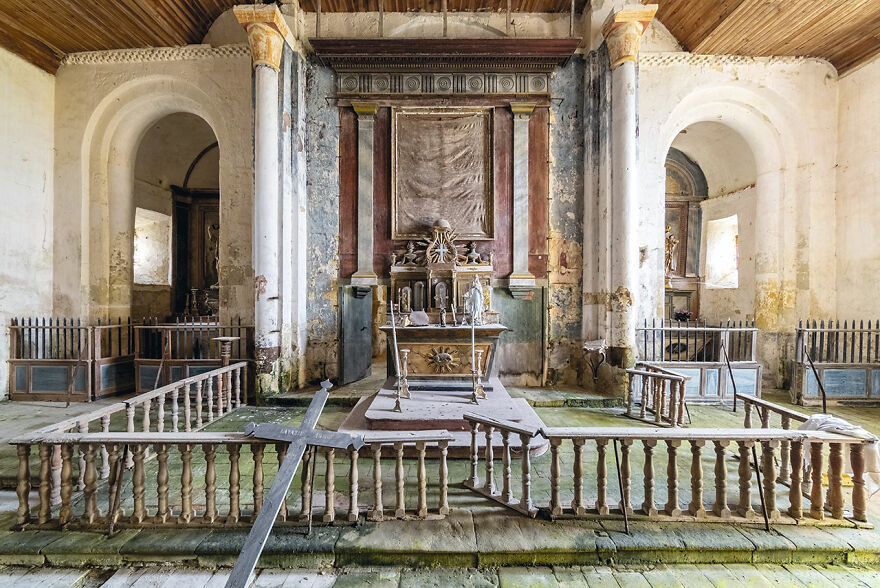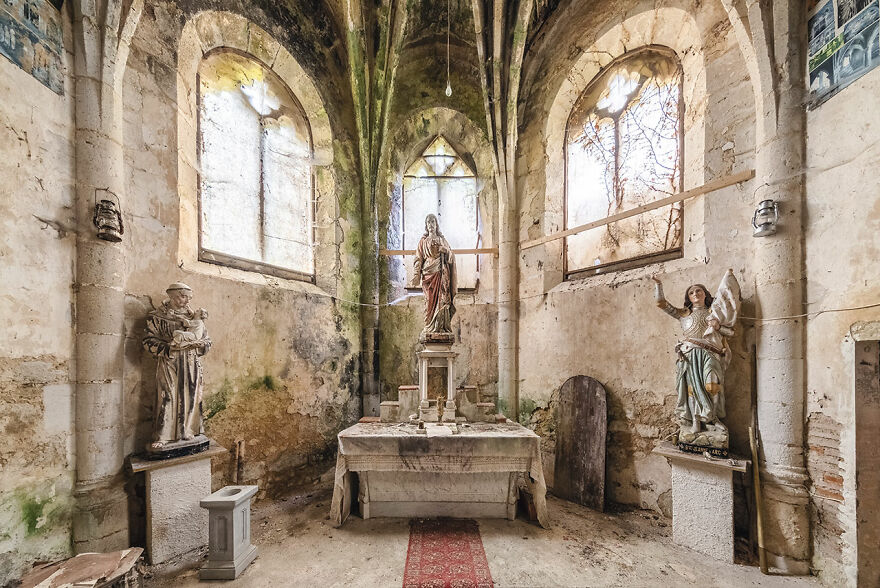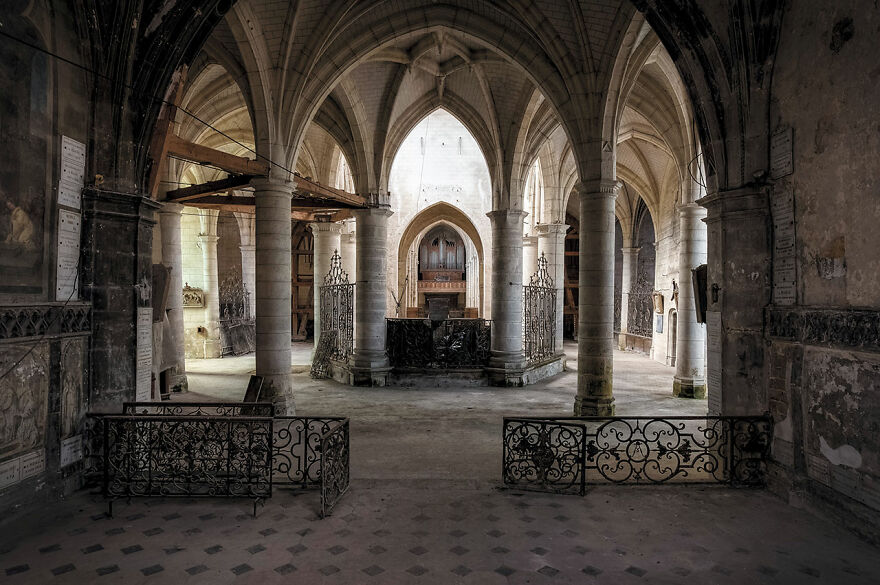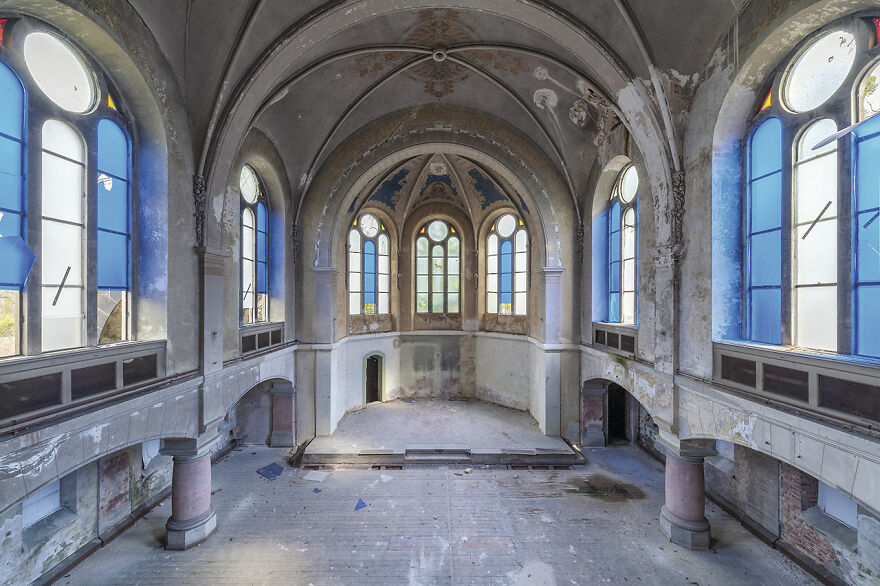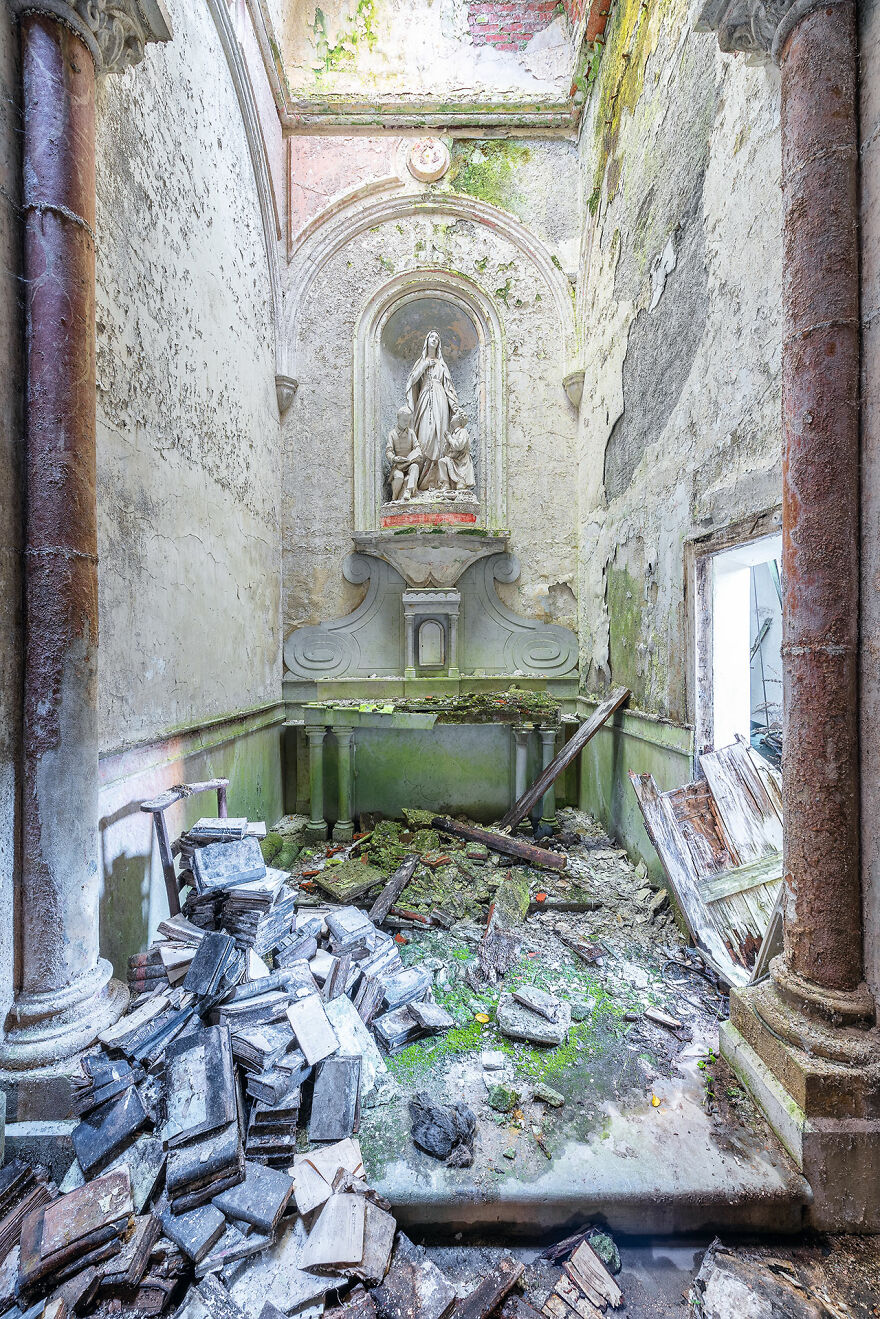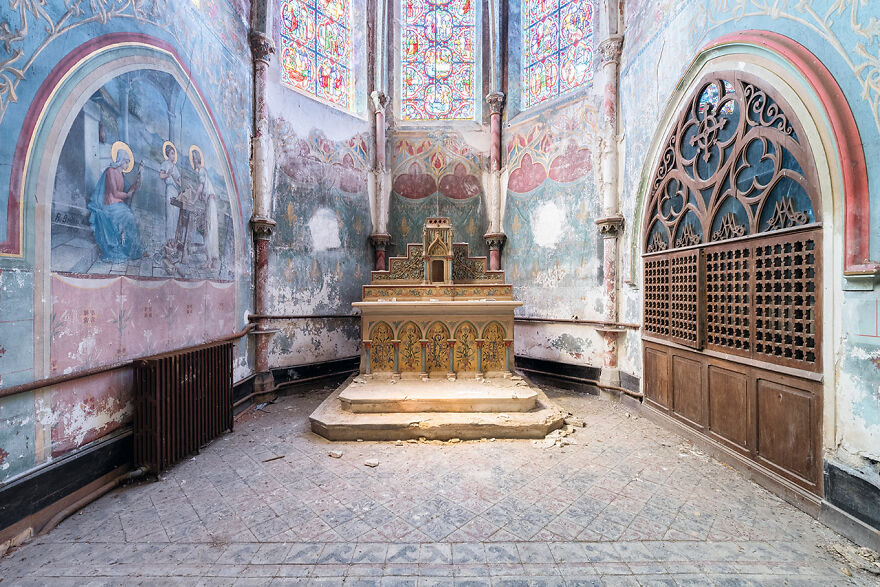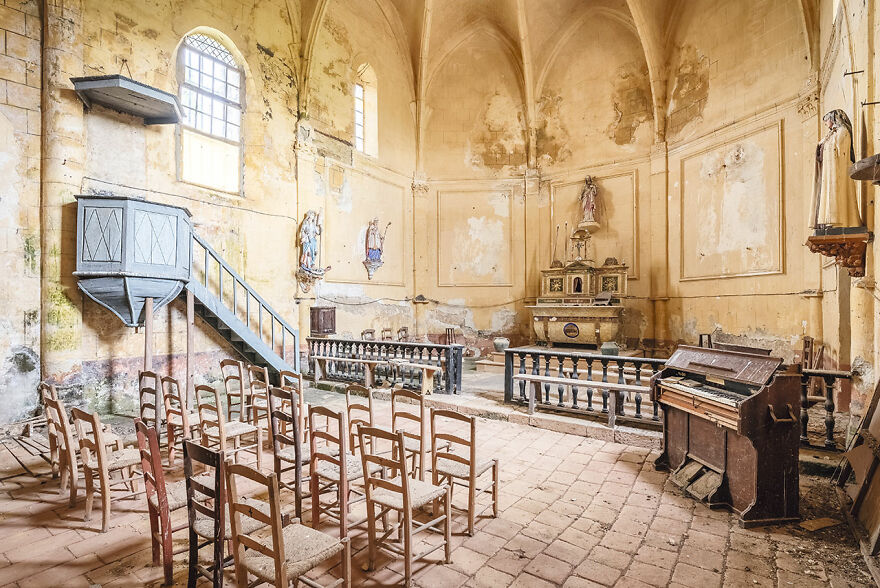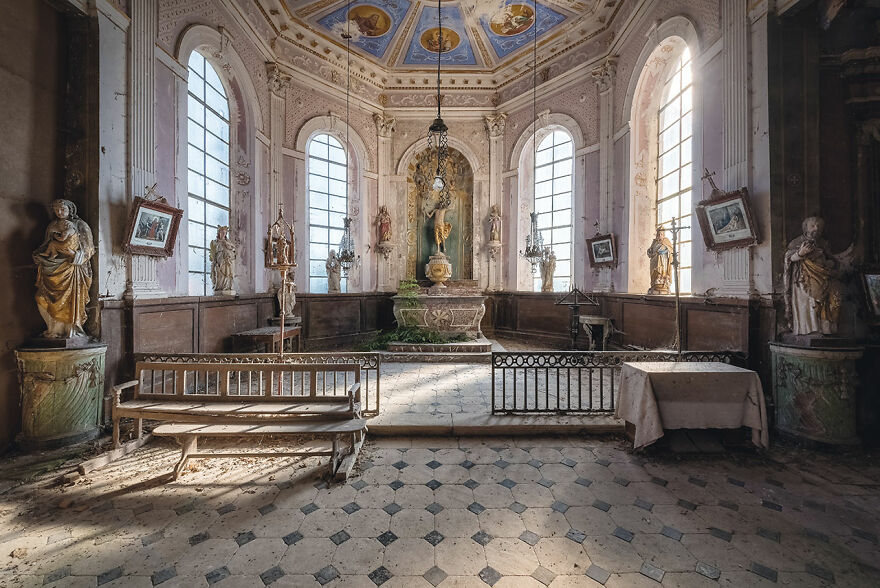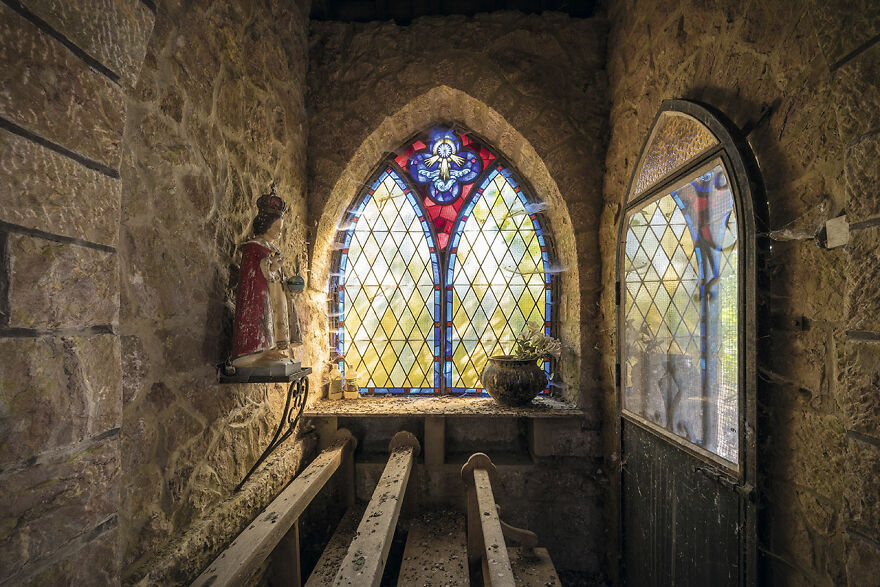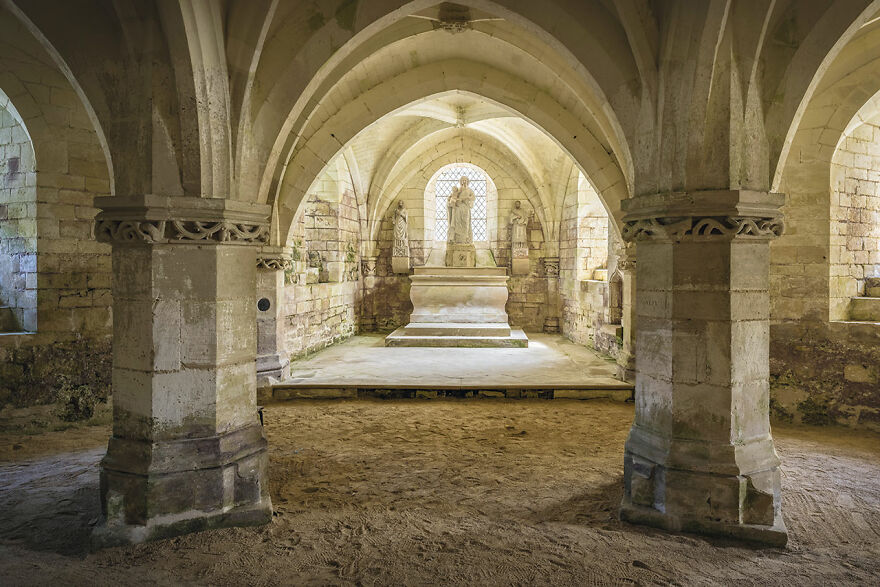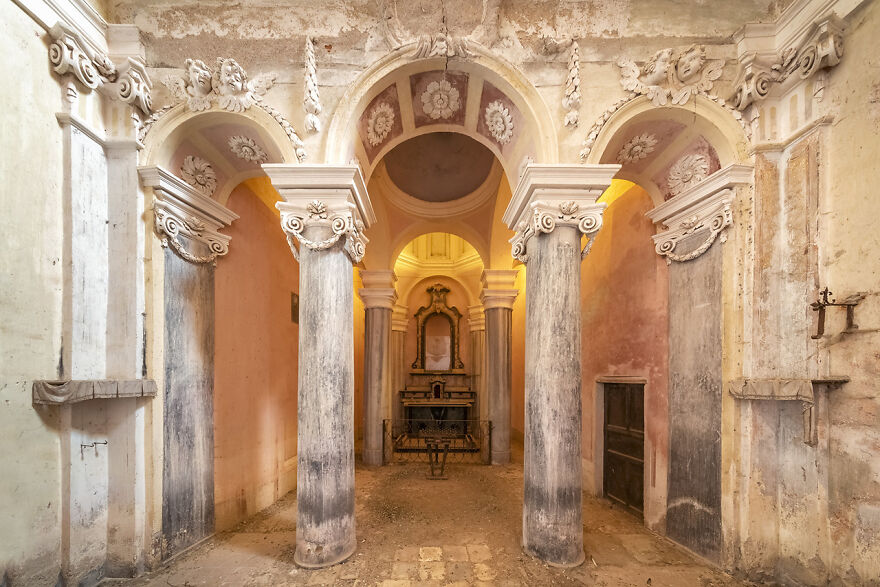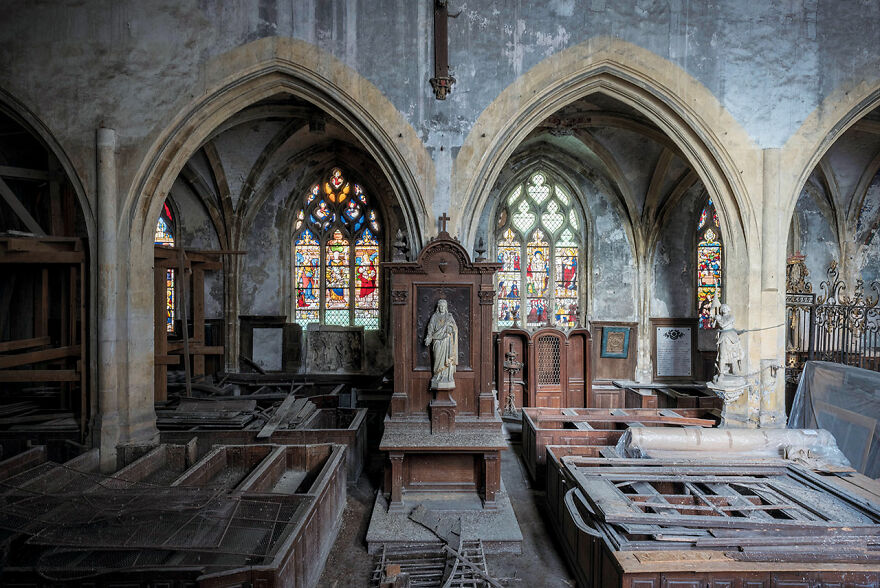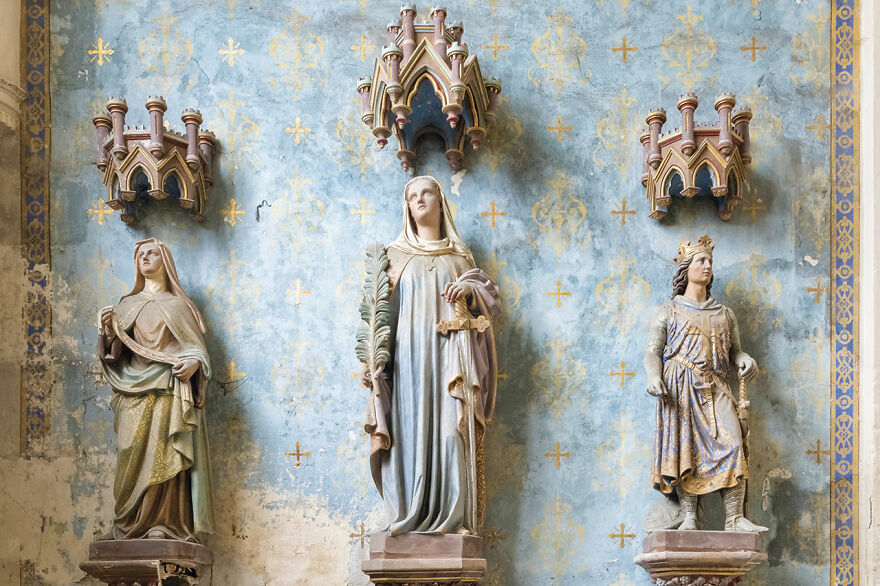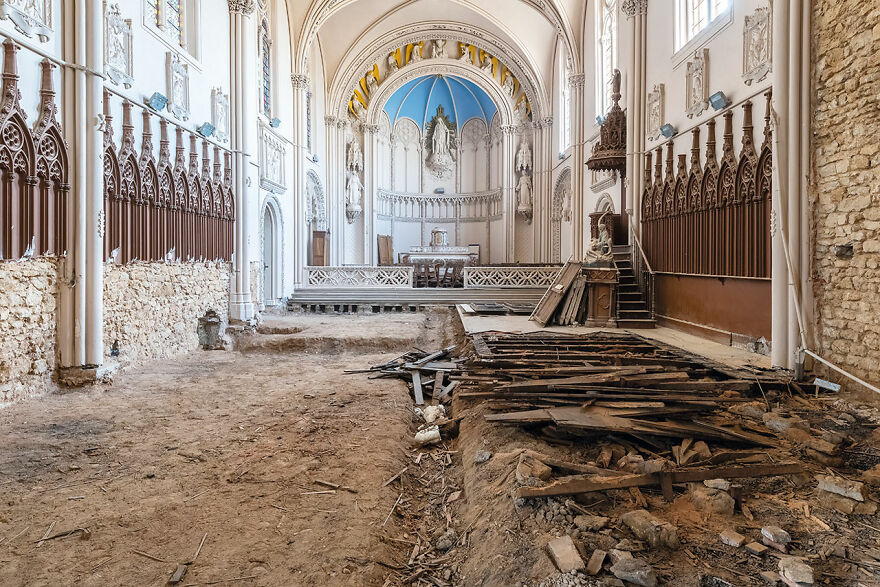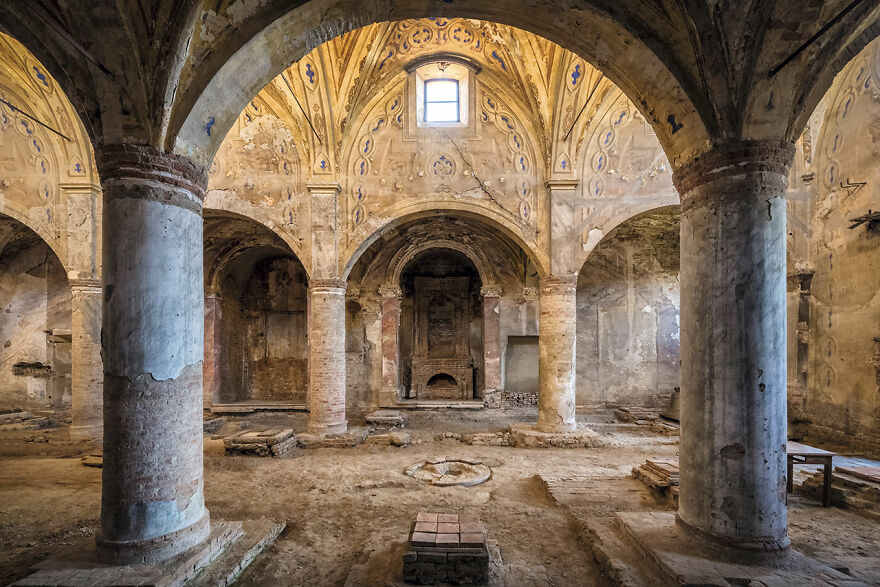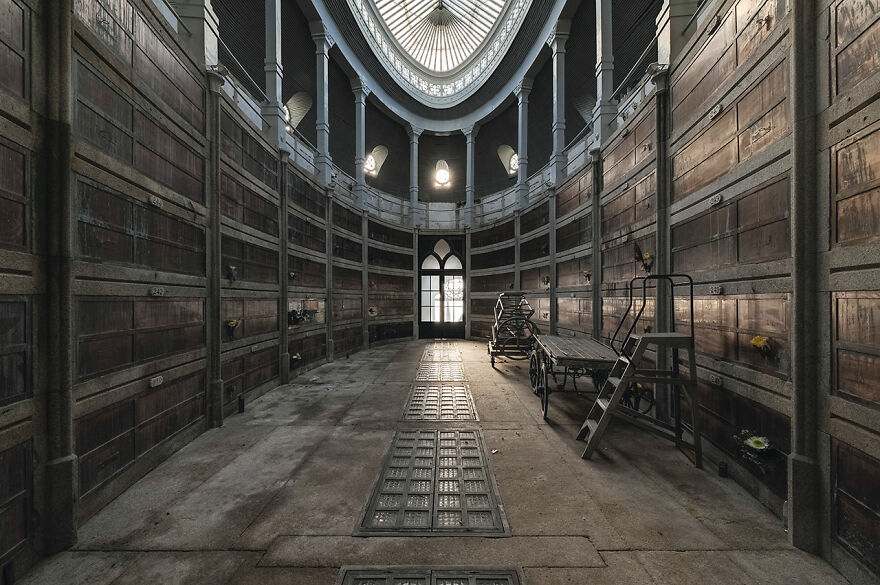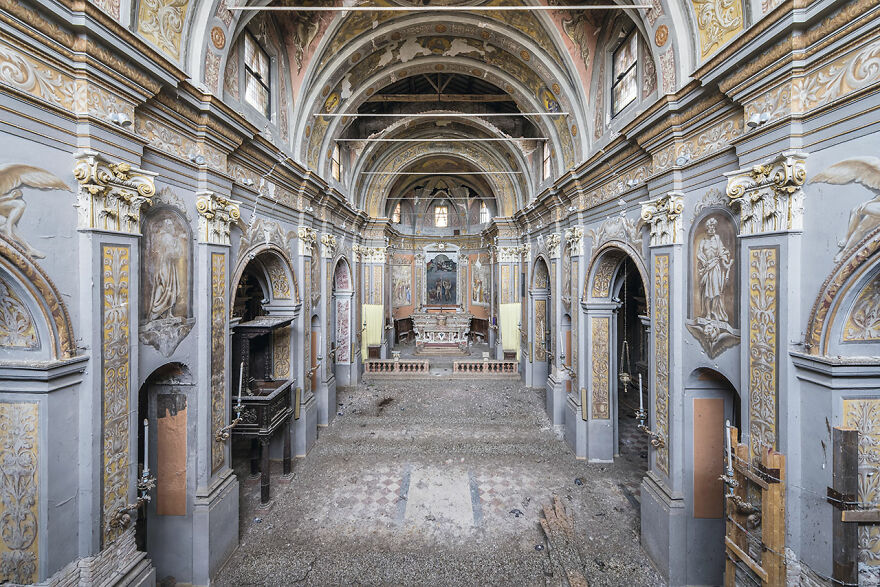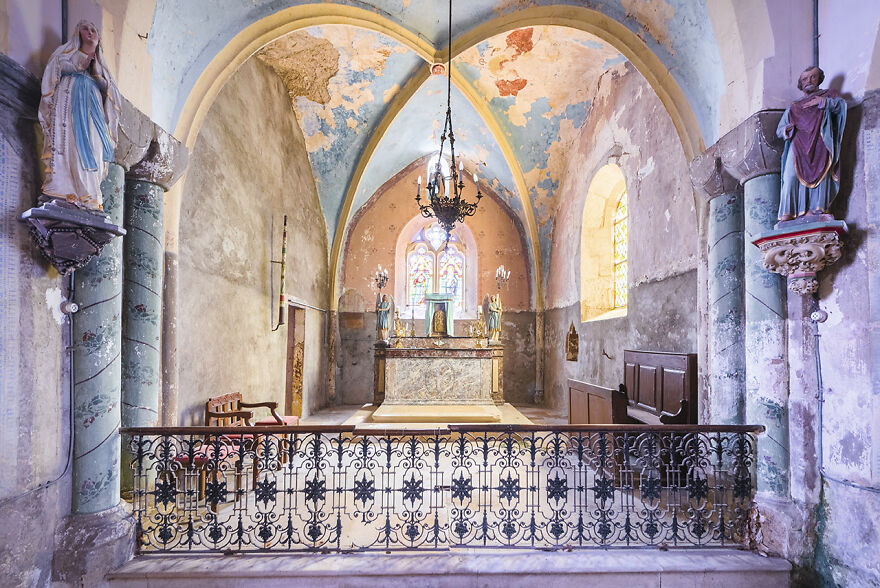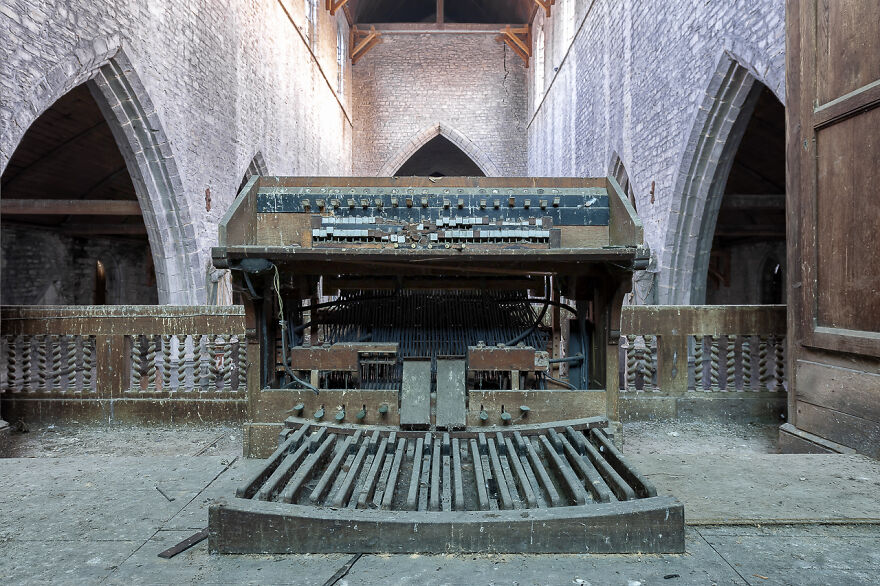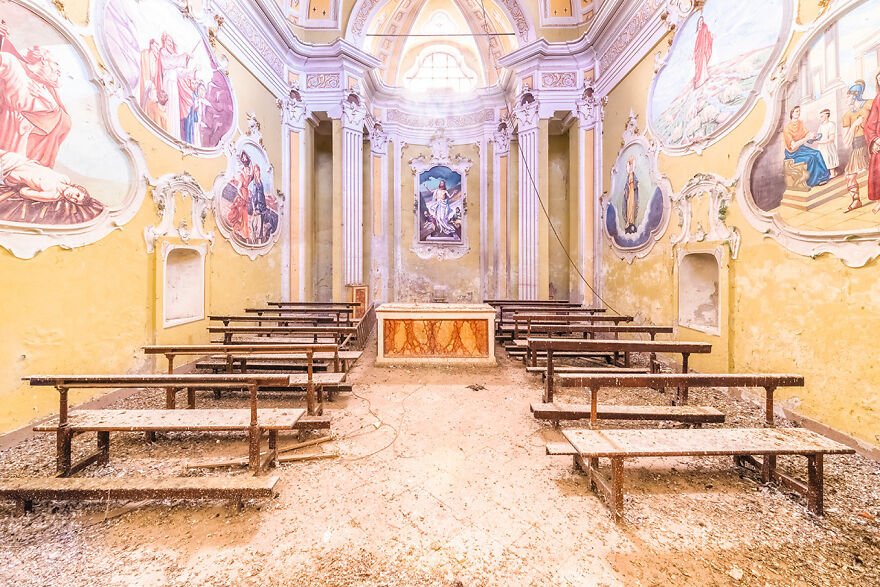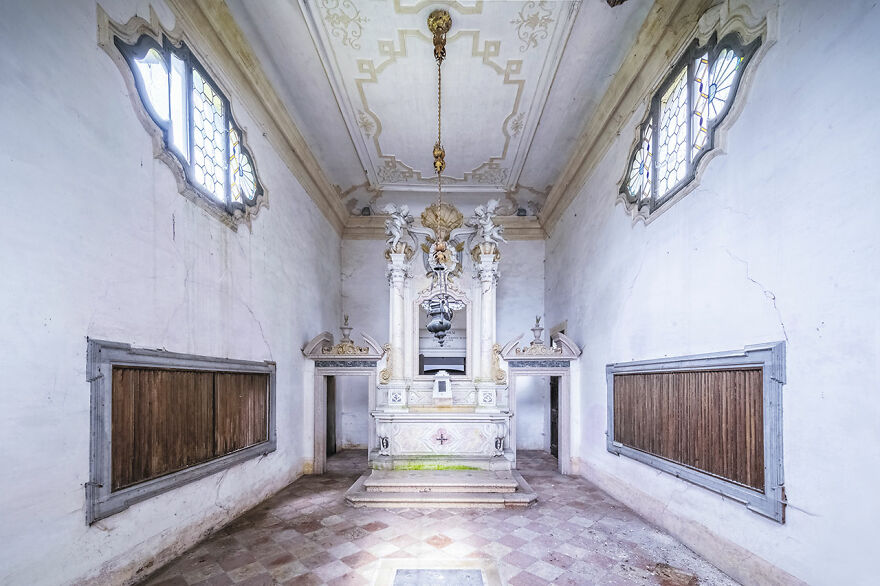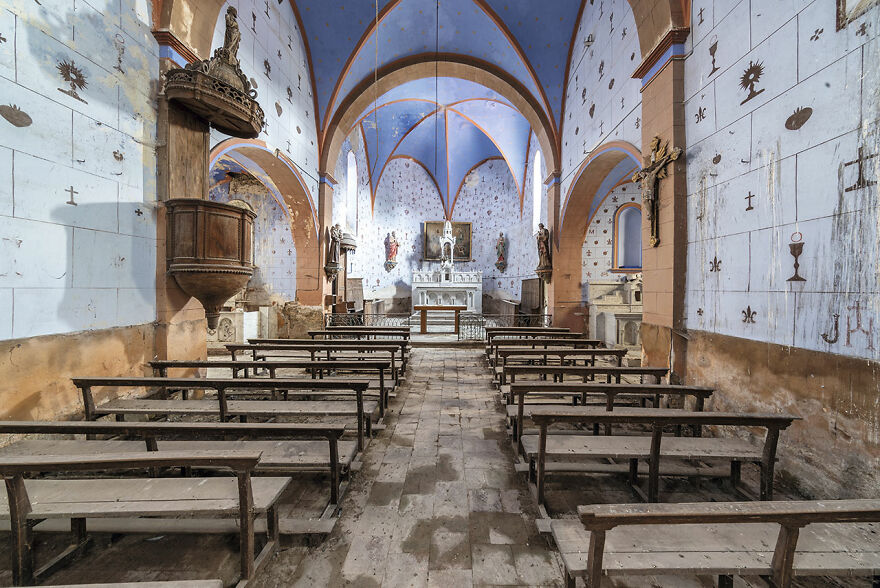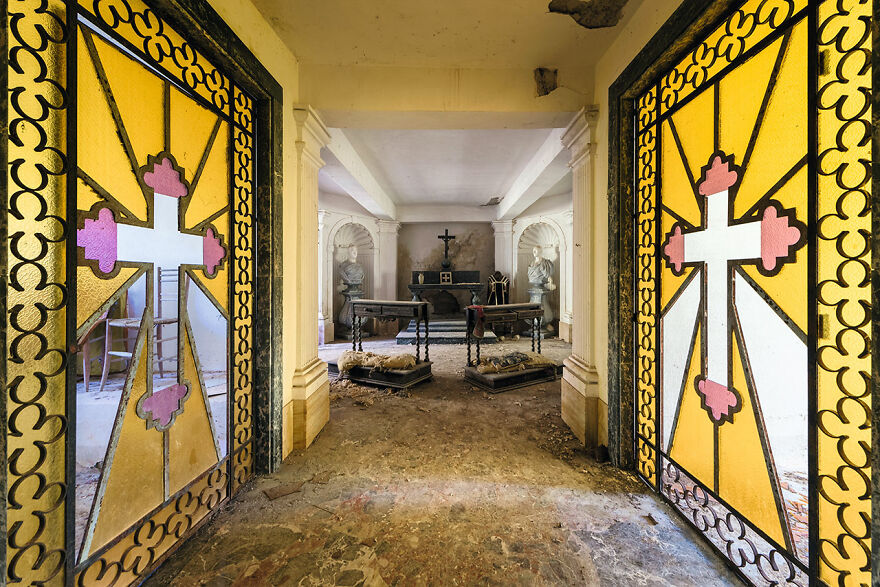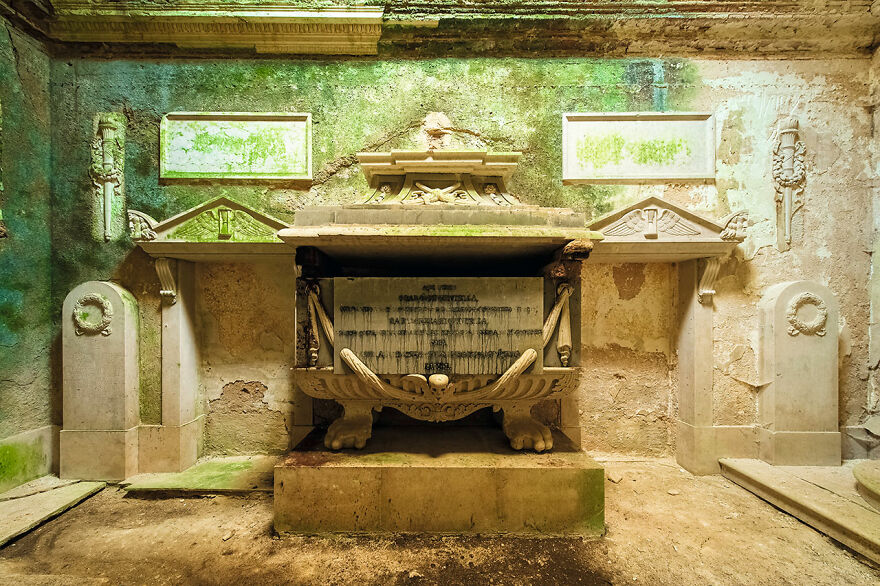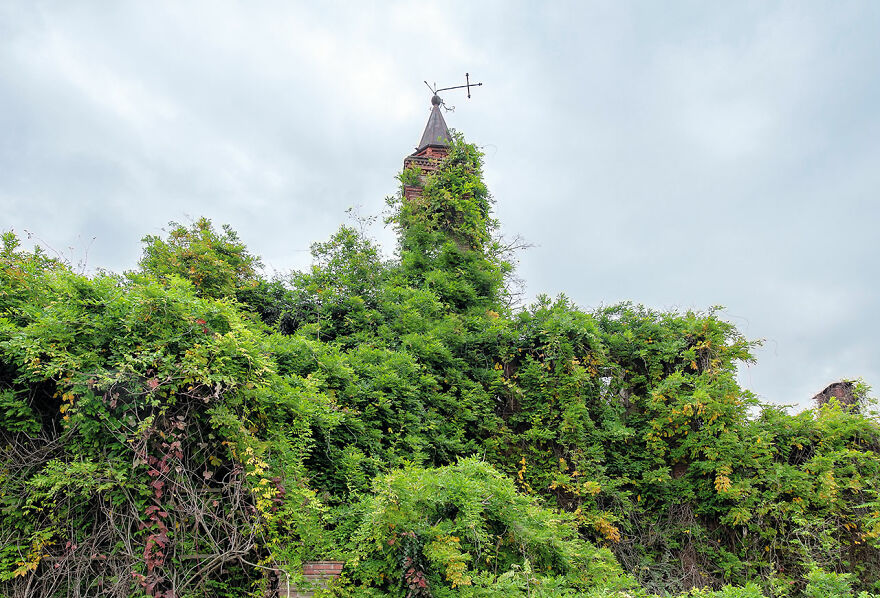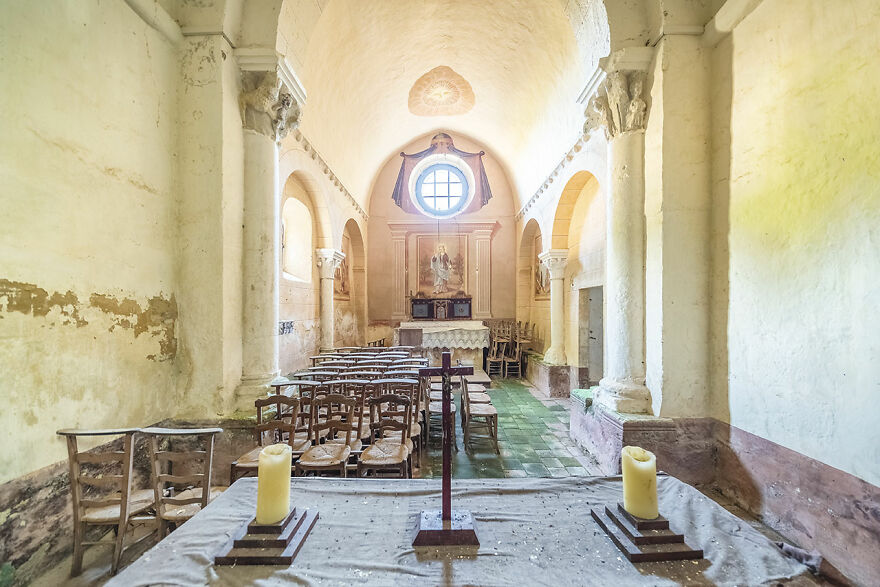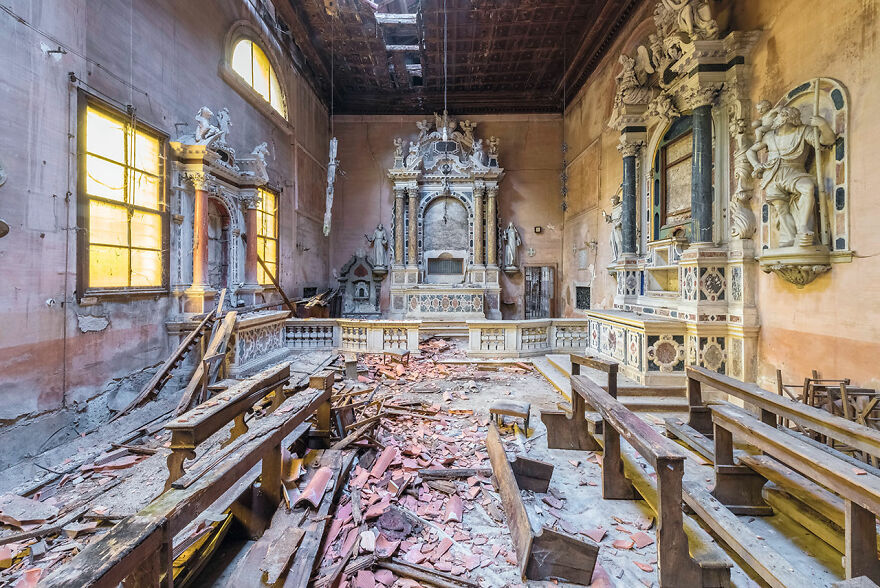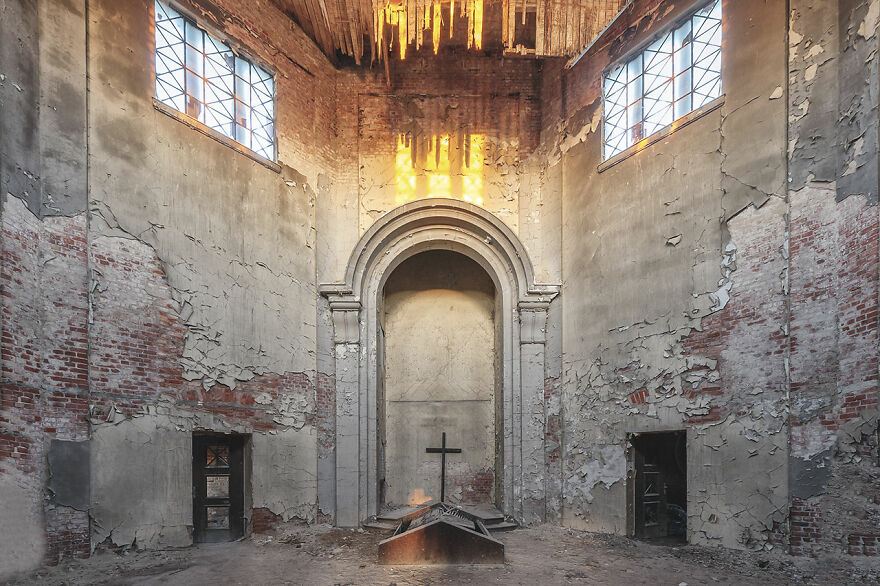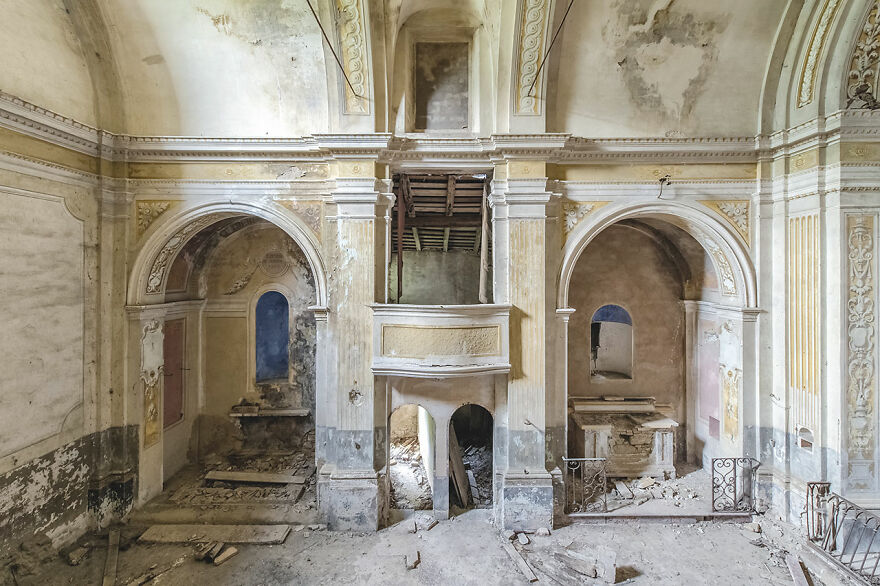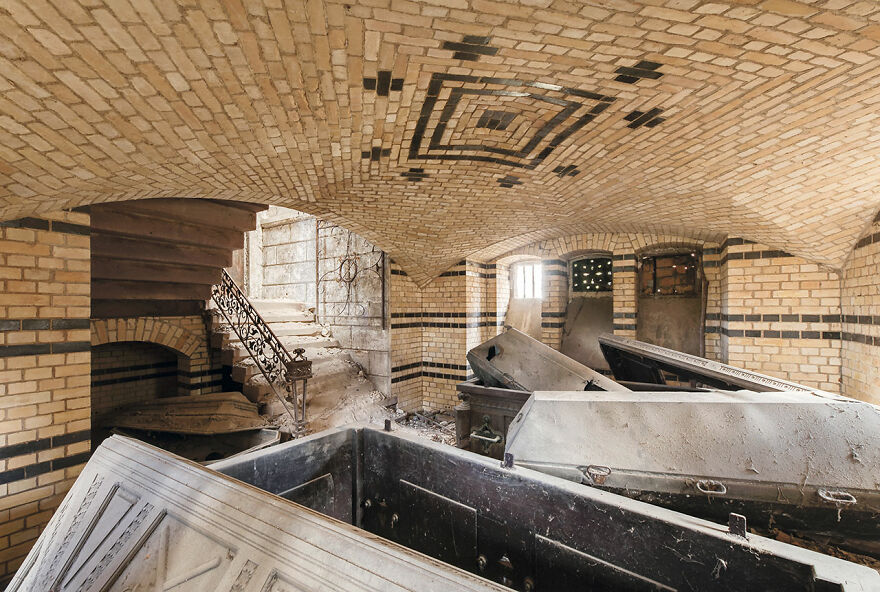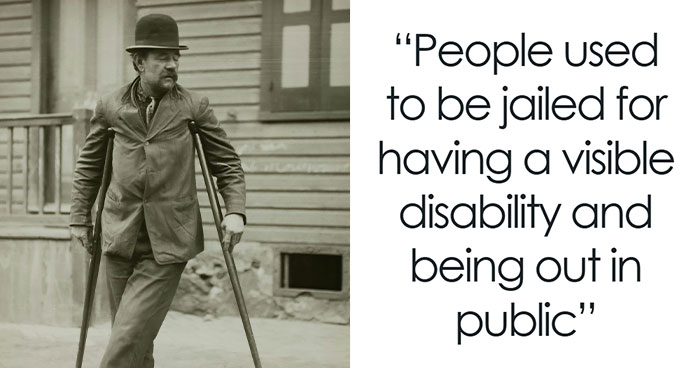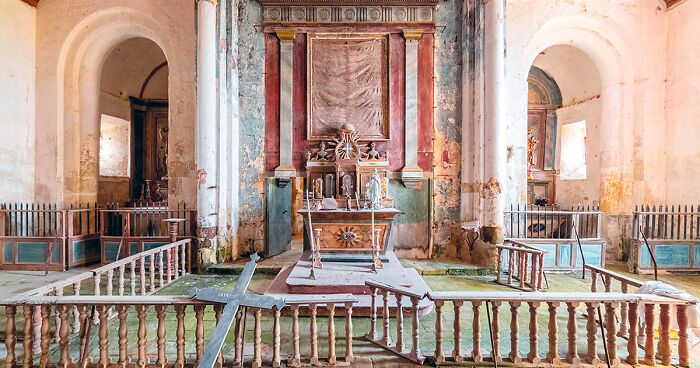
I Traveled Thousands Of Kilometres Across Europe Over The Past 8 Years, Here Are 35 Photos Of Abandoned Churches That I Discovered
Between 2012 and 2020, I photographed several hundred places of worship across Europe. Over time, these places became enveloped in silence. The only thing heard there now is an occasional gust of wind whistling through broken stained glass or the rhythmic drip of water leaking through the dilapidated roof above a nave.
Nevertheless, these muted places still draw an occasional visitor. Once upon a time, prayers could be heard recited in Latin in a German church; and in a French Catholic college, the voices of children once resounded to the sound of the bells. But who can imagine what sounds might be concealed behind the walls of a crypt in the heart of the Italian mountains, or within a tomb in a former convent in Portugal?
Why visit and photograph abandoned or forgotten places? Why have I concentrated my attention on places abandoned by humankind and traveled thousands of kilometers each year to bring back photographs of them? Must a passion necessarily be explained to be shared? Because sharing is indeed what this is all about: sharing the emotions I had when I discovered places of worship that exist in harmony with the ruins of time.
My book Abandoned Churches: Unclaimed Places of Worship is an unparalleled testimony to these places.
More info: francismeslet.com | Instagram | Facebook
This post may include affiliate links.
Sweetheart, Let’s See Who’s Watering You / 15th, 16th, And 19th-Century Cloister, Occitanie Region
“If the site of a ruin seems perilous, I shudder. If I feel safe and secure there, I’m freer, more alone, more myself, closer to myself. It’s there that I miss my friend.” Diderot.
"A cloister. The background of an ageing forest. The tiles are neatly arranged, supporting beams, the cross has been picked up, wild grass grows in the garden. Every place is the place of a projection, in an image, an infinity of images, including this one: a candid place without ringing bells or silent prayers, where possibility and impatience, desire and tenderness, birth and end, resurface. Nothing is more precious than this moment, this image and the dream that it begins again. To hell with ulterior motives, petty strategy. To hell with the pure and the impure! Do not lose your only chance. Enter this room under the sky with consciousness in the place that says yes, yes to the other, yes to love. “One moment to dawdle, a lifetime to regret!” (Jankeleevich). What would these charming stones and greenery be without your breath, without your lovers’ eyes, without your hands and mouth looking for each other? This is a place of pleasure, of miraculous simultaneity, and of lucky reciprocity between body and soul. Your silhouettes against a column, lying in the aisle, mingled and united. So many times! Your wonderful youth!" — Lilyane Beauquel
The Floored Prayer / 11th, 15th, 16th, And 18th-Century Chapel, France, Occitanie Region
"Like every Friday, she came to replace the altar linen that had been stained by the mass wine. We could hear her footsteps from the sacristy, where she put away the liturgical objects. The chalice, the paten, the censer, and the incense holder: everything had its specific place. She had started losing her mind after the death of her husband Georges. This good man used to come to church, somewhat forced, once a year for Christmas Mass. Madeleine insisted on it. Just as she insisted on keeping the closet in the sacristy tidy... The parish priest quickly understood the discomfort this caused. The order in the closet came from the chaos that reigned in the head of his parishioner. That Friday, as she was repeating the Hail Mary for the umpteenth time, she missed the step and slipped on the wet floor next to the console. Holy Mary, Mother of God, pray for us sinners now and at the hour of our death. Her skull hit the stone floor with a thud that caused such a resounding sound it can still be heard today when all is silent. Shh! Father discovered Madeleine’s lifeless body before the Sunday ceremony. The police will come to investigate: it’s customary! There will be no Mass. The autopsy concluded that Madeleine suffered a cerebral haemorrhage. As the tragedy marked the minds of the small number of parishioners, no more Masses were organised and the doors of the church were closed permanently. Ever since then, legend has it that on certain Fridays, the soul of old Madeleine comes to tidy up the church before a possible Mass." — Thierry Pernin
Such a sad story in reality, but what a wonderful non-scary ghost story to tell.
Unburdened Voices / 12th, 16th, And 20th-Century Church, Italy, Lombardy Region
"A straight alley connects the emptiness in the foreground (with its pale yellow-grey floor, this part of the abandoned nave is littered with dark-coloured rubbish) to a high double door on the back wall (a wall without expression, as if at one stage, the church had to close hastily and act like a simple warehouse). The worn entrance contrasts with the luxurious segmented vaults, designed to stretch the space upwards. Set ajar, the door seems to enclose the nave in a manner that demonstrates a continuingly respectful use of the place. A white light filters through two sides of the right swing door.
The aisle symmetrically divides the nave, the equality of which is only compromised by a few details; for example, the disappearance or survival of coloured plaster. While the dominant yellow ochre may evoke gold and its incorruptibility, the degradation of the decorum demonstrates a desertion of the sacred.
However, a powerful ray of light penetrating the nave through an opening high up on the right disturbs the inert crystal symmetry of the place. It crosses the nave in a beam of differing diagonals, highlighting the fragility of the building. Would the spirit be even stronger in spite of the ruin?
However, we discover that the rays of light illuminate small clouds of dust. Where does the light come from? Was it the footsteps of the photographer that made it rise? The benches, empty behind the balustrade that separates the foreground from the background, imperceptibly cover themselves with this light. As if dust is what remains of the impeccable order that long reigned here: priests and servants near the altar; nobles hieratically seated on their prie-Dieu; bourgeois and farmers lined up on the benches behind the railing." — Jean-Pierre Marchand
Red Light, Green Light / 15th And 18th-Century Chapel, France, Nouvelle-Aquitaine Region
"It was well worth the trouble! On the left, Saint Anthony of Padua, the saint who is often invoked to help find lost objects. On the right, Joan of Arc, who saved France from English occupation. In the centre, Jesus of Nazareth, the Christ, who no longer needs presentations. The defence of the Catholic Church. Three of her lights. The first two symbolised by oil lamps and the third by an electric bulb. The Holy Bulb is also filled with oil, a balm mixed with holy chrism, a mixture of vegetable fat and perfumes used for the anointing of the kings of France during the coronation ceremony. All these beautiful people, alas, died young. Chronologically, the only Son of God was crucified in his thirty-third year. Thus, he is represented above the high altar where he reveals his sacred heart. Anthony of Padua died of heart failure and exhaustion at the age of thirty-six and the “Maid of Orleans” died at the stake at the age of nineteen. Carrying a flag with her coat of arms, Joan sits as the war chief on a makeshift pedestal, while Saint Anthony carries the infant Jesus, to whom he dedicated his life. It would seem that the parishioners were about to change the supports of the statues, perhaps even to wash the altar linen, before they lost the key of the church — Saint Peter must not be far. That would have been anything but a luxury. However, to the detriment of the parish priest, but to the devil’s advantage, Brother Antoine is inside and, as popular tradition has it, he is no longer in his right mind." — Thierry Pernin
Detector Of Your Woes / 12th, 13th, 16th, 17th, And 19th-Century Church, France, Île-De-France Region
The Last Stage Of Thirst / 14th, 15th And 16th-Century Church, France, Nouvelle-Aquitaine Region
"Here we are, from the priest’s point of view, on the choir side. Considering the dust on the altar, it has been a long time since the sacramental bread has been raised around here. The eyes take the opportunity to scan some abandoned details. An unlit candle, a faded bouquet, and wedding ceremony baubles serve as souvenirs. Thanks to the two bunches of columns supporting the vault, walking in the nave with a smile on is a piece of cake. Some will think of Charlie and the Chocolate Factory, others will think of Alechinsky. Mint and cherry-coloured paper strips are wrapped around the barrels that make the flowers dance. A series of naive crosses catches the eye. They are closer to the graphics of a video game than to a reminder of the Calvary. Twelve medallions placed halfway up the wall decorate the nave. The implacable Catholic calculations give rhythm to the volume, even empty. No doubt the miniatures of the Passion occupied the believer’s gaze. During his “stare-in-the-air” travelling shot, this believer also had the opportunity to see these icons leaning against the walls, all the while listening to the sermon declaimed from the pulpit. The background of the image is a golden entrance. There is a holy water font, a confessional, and even a stove to warm up beliefs, just in case. For now, a warm light seems to do the job. It has effortlessly slipped through these large openings, but also at the bottom of the staircase that leads to the balcony. Up there, a frame placed right under the rib vault features the “Annunciation” or the “Immaculate Conception”. The Virgin surrenders herself to the light... the Sacred light. It is the only one that hasn’t yet gotten the hell out of here." — Louvre-Ravioli aka François Bénard
The Ready-To-Pray Trade Fair / Early 20th-Century Church, Germany, Saxony Region
"Here we tackle the austere eye and the blue. Do blue and austere go well together? We try to associate, we test the link, the image almost comes free. The axis is always present. It appears fixed, like a potential sextant guiding the eye to a princely perfume. It models our gaze, from an elusive and distant point... humanly it brings us to the front, a thread to infinity, a line, just that one. Again these pointed, structured arches... that reveal to us their ceilings, with palliative plans and without much care, as they cross each other. Windows with repercussions that give a non-artistic rhythm to the lights, luminous acceptances. Yet... there seems to be a balance of blues... this time. The foundation poses and sets up camp at the bottom of the building for the air elements. They retaliate in other ways... these two rounded tops... connect and call each other from left to right ... bis repetita. Approaching the gates of hell, fully submerged... heading to the bottom of the wall... like the stone. To be seen... without a path. To be watched, a little bit twirled. The two faithful pillars set the frame, holding everything together. An empty apse, a report of desertion. These two doors that let air circulate... a visible draught... a cryptic tale and call for help... a telluric breath. The empty element of the altar laughs." —Nicolas Hamm
Mother Of All Knowledge / 11th, 12th, 13th And 17th-Century Abbey, France, Nouvelle-Aquitaine Region
"I’ve already seen this image, when I was a child; not this one exactly, but a similar one.
A young friend and I had managed to sneak into the church in my village, and we explored the areas that were not usually accessible. As we tiptoed through these corridors and stairwells, we had the feeling of entering another century. My grandmother was very religious. She had religious images in her room: Jesus on his cross, of course, but also Mary. That day, I was allowed to enter, through the back door, this obsolete universe, in this fascinating and yet equally frightening iconography, and discover the behind the scenes: an empty, run down place." — Michel Cloup
Fascination / 19th-Century Catholic School And Chapel, France, Centre-Val De Loire Region
A Waltz In Three Quarter Time / 13th, 14th, 16th, And 19th-Century Church, France, Nouvelle-Aquitaine Region
The faithful left after the service and never came back. Did they know it was the last Mass? Everything still seems to be perfectly in order. The tired wood and straw chairs maintain their position as best they can, barely shaken by the memory of the buttocks that have risen from them. With their proud backs, and of three or four different models, some seem to be listening attentively to a neighbour, while others have set themselves apart, hinting at a deserted central aisle. On the uneven floor, pinkish paving stones resist the dust, and in some corners they resist the piles of dried guano. On the right, a tired organ with loose pedals calls for the fingers of a sanctimonious music lover to burble out his favourite hymn. On the left, the milky grey wooden pulpit tries to make a good impression, hoping for a stunt priest to take a chance on it. Two makeshift poles hold it up, just enough to keep up appearances. The choir is wide and high, accentuating the feeling of heavy emptiness. Large windows with unsophisticated stained glass let in a generous light that seems to put everyone in agreement. High up, four statues clinging to their stelae look at each other like porcelain saints. Joan of Arc has turned blond with the sun; it must be said that it is scorching around here. Saint Martin preferred to keep his coat on to protect himself from the celestial ablutions. In desperation, Saint Rita tightens her black veil around her hair. Without a doubt, the pigeons seem to have a passion for the Christ; of all the perches available in the choir, it is on the divine head that they prefer to come and meditate. Many of them have found peace and relief there.
Slight Respite / 15th And 16th-Century Church, France, Grand-Est Region
“How old the world is! I walk between two eternities.” Diderot.
"The perfume of time enters with the dead leaves and the outside air, bathing in beauty and enthusiasm! Underfoot, the wear and tear of past tos and fros, the feeling of continuity. Brightness: the sun brings out the radiant splendour. The bright blue sky of the choir, the beautifully faded pink of the walls, the vivid emerald green, light chandeliers hanging low without crushing the guest, slightly tilted paintings, and a graceful ceremonial crucifix. The gilded statues of draped virgins and saints, sometimes honoured with elegant Baroque figures, appear like benevolent public figures rather than masters of religion. In the gold-decorated niche above the altar, Jesus raises his arms divinely, his left foot elegantly raised, a warm golden cloth floats to his legs — a star represented without any religious terror. Foliage and plants have been deposited by an invisible lover of the place. What a delightful setting, a moment in our civilisation with no order to pray or count the dead, the pain and the constraints perpetrated in the name of religion. A simple stop on a walk in the world and in time, nothing hurries or oppresses. Let’s have a drink; aren’t you a little hungry?" —Lilyane Beauquel
The Glimmers Of Hope Are No Longer What They Used To Be / 20th-Century Chapel, Belgium, Namur Province
"I am the king of the world. Humanity has always ignored itself, despite my message of love. Transported without detour from the factory, spiritually christened “Paradise”, a verger put me in this chapel that has been turned into a shed: a symptom of history. Dressed in once vivid colours, I wear the sacred heart behind my right hand, which blesses indiscriminately. We loved you so much, Daddy and I. It’s all there. The golden crown and the globe in my left hand: if Mummy could see this, she would be proud of her little Jesus. The pious people showed her purity with plastic fleurs-de-lis in a vase straight out of the sacristy, to make people believe in life. Those long silk threads left by the spiders, the sons of the Virgin, remind me of my divine mother, stretching them with her tiny fingers at the end of her spindle. The image is beautiful despite the odourless droppings on the three benches, the trinity is evident, in the name of the father, the reflection of the son in the glass that projects his image back to me: repetitive introspection enlightened by the holy spirit of the stained glass. My feet are a little cold. I don’t remember who entered for the last time, except for the parishioners who were moving out and took the prie-dieu with them, but the scene comes back to me. They had already passed by. Two old men had prayed standing, side-by-side, transfixed. There was snow outside. When their hands came together, they reluctantly asked me if I still had two tickets for eternity?" — Thierry Pernin
Below Everything, Next To Nothing / 12th And 16th-Century Crypt, France, Grand-Est Region
There was nothing to suggest that this crypt was on my route. For the sake of efficiency, I had, as usual, carefully prepared the list of places I wanted to explore during the day; I looked for clues, cross-checked the information, estimated the feasibility that I would be allowed to complete my programme for the day, leaving as little as possible to chance. That was the plan, until I saw that discreet traffic sign on the right-hand side of the road. With just a few seconds to assess what I thought I had read, I slammed on the breaks and made a U-turn to “12th century crypt”. Once there, I immediately noticed the imposing building perched on top of the hill.
As I entered the church, I was quickly disappointed to discover that access to the crypt is obstructed by heavy wooden trap door with a thick padlock, atop of which sat a rather imposing trunk.
To be sure that I had tried my best before leaving, I decided to go around the outside of the building (without much luck) before heading off. My eyes paused on a half-buried railing. Again, ensnared in a chain and a huge padlock . . . Casually, I shook the chain a little to convince myself that it was useless to try. Sometimes luck smiles at you: either it was a decoy, or someone had forgotten to secure the padlock to the chain. A narrow staircase led underground. Despite the lack of light, I immediately saw that this was a place of interest. A forest of sturdy columns with richly sculpted capitals revealed the presence of three chapels barely lit by thin gloomy openings. It was cool; the atmosphere was humid. Verdigris had worked its way from stone to stone, relentlessly covering the walls with an emerald coating. My eyes slowly became accustomed to the darkness and I noticed that the sandy floor had carefully been raked like a Japanese garden. Footsteps indicated that I was not the only one to have made my way among these columns. Standing still, I admired the scene before me, incapable of heading back on my way.
Gloriam Lucis / 13th-Century Chapel, Italy, Piedmont Region
"Generations have probed the supernatural in the visible spaces of churches, cathedrals, monasteries, or convents. And artists competed to create, through beauty, the very reflection of the mysteries of an ethereal kingdom. Architecture, paintings, tapestries, stained glass windows, statues appeared like a vision before the believers. Extraordinary achievements, a triumph of styles! Symbols and attributes, figures of theology, vices, and virtues were as striking as the light shining in the darkness. Symmetry, harmony in the designs of the buildings, power and simplicity, storytelling, composition in the statues and paintings: the bodies appeared under the draperies of stone or paint, figures seemed noble and alive, the altarpieces opened onto transfigurations.
Here, all that remains of this theatricality are the solid sections and sculpted lacework of a plundered décor, a door closed on a past of sacristy, a silent confessional, an empty pulpit, and a few eternally youthful cherubs. Where are the faithful, alive, and warm in their fancy Sunday attire and silk gloves? Can their voices still be heard, celestial and tenacious, floating in the air around the sturdy solidity of the altars, columns, vaults? For those who have faith, what a frightful sight to see today this nave without a pilot, without sailors, without passengers for the afterlife!" — Lilyane Beauquel
Hand Me Over The Sky / 13th-Century Church, France, Bourgogne-Franche-Comté Region
"My solitude within my church. Even though little Jeanne is making a considerable amount of useless effort. Only the two of us remain still standing, while everything is falling apart. Jeanne protests vehemently, but the diocese delays, and the municipal team wonders. About the need for such a complicated and costly shoring. About a possible misappropriation of the site. About my probable disaffection. My solitude within my church is terribly clogged, obscured, encumbered by its materiality, but nevertheless, it summons its patience. And I quietly wait for a naked faith to come. And with it, the light." — Sylvie Robic
I Saw The Light / France, Bourgogne-Franche-Comté Region
"A hieratic, impassive saint gazes fixedly to the sky holding a sword, instrument of passion or struggle, and the palm leaf, that heaven grants her. Is the king her servant or her assassin? And is the woman at his right his wife? No, these are three holy figures as the pedestals and niches show. Saint Catherine of Alexandria at the king’s side. Eternally waiting, they call out to the rare guest who falls upon this place, which is now only visited by bygone memories. Against a sky-blue background dotted with crosses, the three abandoned statues await the resurrection of a forgotten church. The statuary, which at first sight was thought to be made of beautifully carved stone, is only plaster, as evidenced by the pedestal on the left and its gaping wound. This late 19th-century creation probably deserved more than being abandoned like this. Of course, this commissioned statuary, made in a factory, is not prestigious. There is no illustrious signature on the base. Is that why it is worth no interest? A whole world is slowly disappearing, despised because it is too close to us, as if architectural and statuary youth were a defect. One day soon the nasty teeth of a mechanical shovel will turn our three statues to rubble. Perhaps a worker will take one last look at these sculptures. Will he make a plea to the Virgin to be forgiven?
How many statues, left out in the freezing cold of empty naves, will join them? This is the great misery of what was the pride of the 19th century in France: in less than a century, more churches and chapels were built than in all the previous centuries. When one of these constructions disappears, it is a small piece of our history that falls into oblivion. Each of these statues tells us a story and bears witness to the beliefs and venerations of a century. Each one was, in its time, venerated, and let us rest assured, the women of the people came to lay flowers at their feet." — Christian Montesinos
¿Cuál es su ubicación exacta? ¿Cuál es su nombre? ¿En qué pueblo se esconde? ¿A quién ha sido dedicada?
The Foundations Of Faith / 18th And 19th-Century Chapel, France, Grand-Est Region
The old hospital seems deserted. After passing through a small gate overlooking the street, I quickly spot the chapel in the middle of the site thanks to the characteristic shape of its domed bell tower. A door seems to be open. I enter. The triumphal arch that marks the entrance to the semicircular apse is decorated with a flotilla of kneeling angels armed with banderoles. In the centre, just above the altar, a Christ enshrouded in divine light seems to want to free himself from weightlessness. The scenery is richly sculpted with foliage, heads of angel musicians, birds, an eagle, a phoenix... At the foot of the altar, a heap of pews stacked to prevent any circumambulation draws my attention. It looks like they have been put in quarantine. As I step down the few steps that separate the choir from the nave, I discover that the dirt floor has been torn apart by a long gash strewn with rubble and pieces of worm-eaten wood. Contaminated by an incurable disease, the woodwork has been torn off and partly removed. On the right side, there are still some boards at the foot of the pulpit, on which panels taken from the walls have been laid to rest. A devastating virus seems to have spread insidiously from the ground upwards, exposing the stone in its inescapable vertical progression. Is this how hospital chapels die: waiting to also be affected by the pains of the residents who have come to pray for their recovery? No. Multiple fluorescent catheters perforate the walls, hinting at a vaccine injection in the heart of the stone. I will return to this patient’s bedside to inquire about its health.
Truth On Earth / 12th And 13th-Century Church, Italy, Lombardy Region
"From magnificence to impending ruin, the place seems to have been frozen in time, with the exception, in part, of the pillars, the bricks, and the painting of the vaults. Under its dome, grandiose ceremonies or simple baptisms must surely have been held. Comparisons with the great buildings of past centuries immediately come to mind. Who still makes churches on a Latin cross floor plan? We can only imagine the floor tiling that has disappeared, and of which only the base of the oval cross-sectioned columns remains as a testimony. The floor slabs have probably been removed and placed in a secular place. In the centre is what seems to be a well, or the traces of a baptismal font. The columns have lost their splendour. They are now nothing more than an assembly of bricks, covered with a layer of plaster that is gradually crumbling away. The rib vaults still have their original decoration and give us some clues: an eclectic architecture, mixing Romanesque, Gothic and Early Christian styles, suggesting that this construction dates either to the Baroque period, the 19th century, or maybe even a much older period. And a number of modifications make it hard to determine the actual construction date. Here and there, rectangular compositions on the ground are reminiscent of funerary tables, or even constructions evocative of ancient cenotaphs. The originality of this religious place deserves more than to be forgotten. Is it waiting for its Prince Charming, who, with the swipe of a credit card, will bring a new breath of life? Will it become a place dedicated to art? Or more simply a renovated place of worship? But who will come all the way here? Who will push the doors of a forgotten church that believed, back when it was built, that it would still be relevant in the centuries to come? We are the mere image of this place. Destined to be forgotten, to disappear, gradually losing our youth, and moving towards an end. Everything passes, everything fades away, and the reflection of agonising monuments should invite us to practice humility." — Christian Montesinos
The Last Address / 21st-Century Crypt, Portugal, North Region
"I hoisted myself up a ladder above the cold room, where small glass paste tiles let the day of the dead through to the dedicated space and to the last box, as I went along the walls of my library to fetch the book I was looking for. Hundreds of numbers, bouquets of glass and ceramic flowers, glazed metal, wood and marble: this is the industry dedicated to the transport from one body to another, from one place to another, turned wheels, springs and cranks, raised steps and trays, in the delicate palm of the Deposition, where nothing less elaborate than a dwelling served as a final resting place. Everything was joined together in an ordinary, anchored building. One slides, lifts, hoists, pushes, places horizontally. The bar that neither holds nor turns requires the necessary strength for the last stance, and it is an elbow that bends under the weight of the deceased.
Germaine told me that you wouldn’t feel it go away, because one breath was enough to get rid of the weight that weighs you down. I was sceptical about her strong assertions that were intended to free us from the bewitchment of our friend’s disappearance — you could feel when a breath passed by. So, I adjusted my camera to take a picture. The shot went off like a crack of thunder and multiplied several times according to the settings I had established. We saw the light escape in three stages. It ran faster than a shadow through where it had entered. In the blink of an eye it was already dark. Since then I have been carrying my friend, and together we laugh at the idea of having depopulated the premises." — Frédérique Villemur
Jesus, The Saints And All The Tremor / 16th And 17th-Century Church, Italy, Lombardy Region
"For the time being, we haven’t taken care of it, the contractors are already busy, the renovation of a castle is no little matter, but things are progressing, I am very satisfied we will probably be able to open in the spring.
I’m not worried; there are no luxury establishments in the region and no competition. I really had a brilliant idea. For the chapel, I have to admit that I do not really know what to do, I have not taken the time to think about it, and for the moment it’s a bit of a mess. Having said that, the lighting in the room is great, it is beautifully proportioned, and directly connected with the castle — it has real potential. And then there is this central element, in a Baroque style and with an incredible yellow fabric. I did a decoration test, for the fun of it, with a bouquet of plaster flowers that I found in a cemetery. Frankly, it looked great. " — Sylvie Robic
It Will All Work Out / 12th And 16th-Century Castle Chapel, France, Grand-Est Region
"Always in the axis, double arch with golden features, taut double arch with frescoed remains... on each side, a statue, therefore... two guardians of the image: one... a virgin, the other... a very colourful saint... the columns outlined with barely visible, fleeting, moving strips... a vault medallion presides... with a central... even self-centred position, “in visibilio” again. A hanging chandelier seems to answer for its ironwork at the edge of the altar, which is far away, at the very bottom of its history. A pew, on the right, in prayer... maybe... in discussion... at best, in waiting... is also in a dialogue with its alter ego... longer and so much in front. Two orderly angels carry shabby candelabras... a stained glass window... on the right, or a garden, it depends, powers a soft light: the one that will arouse a mystic-like ecstasy for a moment. Diametrically, a sculpted and hanging handle answers for its superb, its place... its shape and its semblance of coloured shadow. To him. In the background, another intact, openwork stained glass window watches over and surprises this tabernacle... a golden door... A long step nonchalantly sprawls out in front. All the candles are electric and try to make us believe in a system that would have, one day, modernised the space... where sockets and switches act as delicately obsolete supports. The inhabited marble altar." —Nicolas Hamm
In Your Villainous Memory / 13th, 15th, And 18th-Century Church, Belgique, Hainaut
"I’ve seen this image many times before. I was much younger, I was in a church and there was this man in a dress who was raising his arms to the sky as he sang. I was much younger, overcome by pain and anger. I closed my eyes and I saw this image, not this exact image but a similar one. And every time I opened my eyes, I saw this man in front of me again. Every time I closed them again, I was brought back to the second image. For a second, I thought that by concentrating, I would succeed in making everything explode, in devastating everything, in reducing to dust this unbearable reality, like at the end of Brian de Palma’s Carrie or at the end of Antonioni’s Zabriskie Point, a magnificent and liberating destruction." — Michel Cloup
In Contrast / 18th And 19th-Century Chapel, Italy, Lombardy Region
State Of Mind / Early 18th And 19th-Century Chapel, Italy, Veneto Region
"The traveller awakens at the heart of a white parallelepiped that seems to extend infinitely. The traveller? No one knows where he comes from? No one knows when he comes from?
For him, the only point of reference in this escapade is the checkerboard floor covered with alternating squares of white tiles, worn by time, and reflection-free natural bistre tiles.
The light seems to emanate from the centre; more precisely, at the foot of a black stele embedded in the floor. Engraved with inscriptions that the traveller cannot read, this deep black stele seems to push the light towards the ceiling.
A lamp hanging from a long golden cable falls from the high ceiling! This cable is like a line that prolongs these friezes in angles and golden arabesques, remnants of random and cabalistic paths towards the unattainable. Beyond, an altar erected for forgotten gods dominates the heart of infinity, of this checkerboard. Made of immaculate marble, it creates, like an Yggdrasil, a bridge between earth and sky. The mirror in the middle reveals the back of the traveller. It is a focal point, supported by the perspective of low windows, long rectangles that were sealed in the old days — what abysses, what monsters hide behind these bars in order to be forgotten?
Only the pupils of the high windows act as exits, inaccessible but open to the light and towards an unknowable elsewhere!" — Samuel Nowakowski
Stars In The Eyes / 19th-Century Church, France, Occitanie Region
"We climbed through the forest in single file, sometimes at night with torches. And up there on the moor, she would appear. Small and stocky, encircled by large, flat, mossy stones . . . turned towards the sea. After the damp porch, a drunkenness of light, a ship’s hull overturned above our heads to protect us from ill fate. When the regular Masses ceased, candles continued to be burned there: for a school exam, a driver’s license, a medical
exam, a love wish, for anything and everything. I think it lasted until the great storm of ‘77, when so many boats did not return. We felt betrayed. Yes, that’s right, it was after ‘77 that the village really deserted the chapel." — Sylvie Robic
Close To Privileges / 14th, 16th, And 19th-Century Castle Chapel, France, Nouvelle-Aquitaine Region
"One of those chapels that was so often built next to some convent. A simple architecture whose high windows were the only source of light. The whiteness of the walls did the rest. The apse, of Gothic inspiration, is only the extension of an austere nave, lifted only by committed pillars. The Corinthian-style capitals, along with the ornaments of the vaults, are the only elements bringing a spark of gold. A blue vault recalls the sky. The statues are limited to the essential: the Virgin and Saint Joseph in the apse, and a large crucifix. There are some images on the side walls. Was it the Way of the Cross or the representation of some saint? There is a side door pierced into the south wall, another one opposite leads to a room that is probably also abandoned.
How many of them, men or women, came to pray in this chapel, addressed a prayer to the Virgin Mary, or made a plea to St. Joseph? The songs to the glory of Jesus and his disciples and the murmur of prayers could be heard in calmness and devotion. To those who entered the place, everything seemed so luminous, so simple and so grandiose at the same time that they found peace and comfort here. Tears could also probably have been heard, and many a teardrop brought a blessing of pain to the ground.
Today, some immobile chairs still attend silent services, and the servants no longer ring the bells or bring the mass wine. The only witnesses to these sleepy services are now nothing more than splinters of stucco, plaster, and paint that no one looks at anymore. Yet the neatly arranged chairs suggest that from time to time, very rarely, there may be a service attended by old ladies and people nostalgic for a bygone era.
If one day our footsteps lead us to such places, let us not think that they are dead. They are asleep.
Let us come here with curiosity, with eyes wide open and a sympathetic ear, and with a bit of luck we may just hear the breath of angels." — Christian Montesinos
Combining The Useless With The Unpleasant / 19th-Century Chapel, Belgium, Namur Province
The small chapel was the only surviving building in this area, near a huge working quarry; the kind of quarry that leaves a thick cloud of white dust for several kilometres around. As I approached the location indicated on my GPS, I saw the landscape change and gradually lose its colours. Everything was white around me when I parked in a gravelled carpark destroyed by construction machines. Dodging the countless puddles of whitish water, I came closer to the building. I pushed open the door thinking I had found a place of refuge to breathe again. But it was the same inside. The dust had been meticulous, covering indiscriminately with a thick layer of white dirt everything that was there. How could they? There were piles of wooden pallets, piles of broken boards, basins with holes in them, buckets of dirty water, tools thrown on the floor. A makeshift table had probably been used by workers to break bread and have a drink. Another table a little further away displayed a number of screws, bolts, and nails of various sizes. The small sacred building had been used as a workshop, a shed, a canteen... and a toilet. The panes of the pointed windows were all broken, allowing rays of light and sparkling particles to easily pass through. To the right of the choir, an attempt at a repair had been made with a tarp, planks of wood, and corrugated iron. It was a lost cause. This was not one of those forgotten buildings in which time had patiently served its purpose, gnawing at the walls, piercing the ceilings, causing the paint to crumble... Someone had added a layer! As I turned around, right above the door through which I had arrived I saw a wooden balcony that did not look ready to give way just yet. However, the stairs had given way. Using a ladder that I found there, I decided to climb up to assess the magnitude of the disaster: the Apocalypse was not expected the following day.
The Punishment / 20th-Century Crypt, Italy, Liguria Region
"A gashing wound ruptures the light grey background, against which is an altar for the faithful. With its left part demolished, the altar, standing atop a base, appears fatally wounded. Ironically, just like the cross of a viewfinder on a camera or a gun, a small square surrounded by a gilded frame surrounds an equal-armed cross. Higher, a crucifix compliments the scene.
Two noble busts, proudly sitting on their pedestal, frame the altar on a background of scallop shells: a space with no miracle or mystery.
And as if at any moment a priest could emerge from nowhere, a dark vestment with gold trimmings waits on a headless mannequin to the right of the altar.
A few steps behind, two high chests of drawers are arranged symmetrically to form a wide angle. Each one has two drawers. The drawers of the chest to the right are open, while those of their counterpart on the left appear closed. Their contents must have included altar bread, pure white cloth, phials of wine, tongs, and bowls.
The chests of drawers rest on tall, slender, twisted legs. But, as if the occupants had officiated in an already dilapidated place, heavy bags — did they contain grain, sand or gravel? — were placed on the base to ensure an overall stability. The base itself forms a platform on which the legs of these chests of drawers rest.
Towards the exit, two large white orthodox crosses accompany us and form a corridor. Each cross is made of the yellow material of two large stained glass windows, where two equal sections in the form of a ray of light have been broken and profusely reveal the profane world. On the floor to the right, a yellow frieze is still there, while its counterpart on the left stained glass window has lost both its glass and its colour." — Jean-Pierre Marchand
Heading Towards Oblivion And General Forgetfulness / 14th-Century Convent And Crypt, Portugal, Lisbon Region
"I’ve already seen this image in a dream; not this one precisely, but a similar one.
I had a Go-Pro camera in my hand. I was making a kind of documentary series for my YouTube channel, in what seemed to be a distant future. I was showing children and teenagers places they didn’t know, places that were the remains of a past civilisation, of a bygone era: fast-food restaurants, huge factories, slaughterhouses, television studios, shopping malls, places of worship. Everything was damaged, partly destroyed, and abandoned. This one had suffered from the rising waters. Then I filmed their reactions and talked with them. That day, none of these young people believed me when I told them about the different religions, the rites related to them, and the crimes committed in their names. They were afraid, and asked to leave as soon as possible." — Michel Cloup
I Need You / 13th-Century Chapel, Italy, Piedmont Region
Candle Songs / 12th, 16th, And 19th-Century Castle Chapel, France, Nouvelle-Aquitaine Region
"Now this is a beautifully high ceiling under a semicircular vault. The decoration is minimal, as if it were whitewashed, faded by the passing of time. The floor is also worn out. The immobile stone is riddled with woodworm. The fault lies with the fact that no one has walked here for so long. In the foreground, well-aligned chairs gaze patiently at the central stage. A pulpit waits in a corner for a reading or a reader. The stage on which the altar stands is delimitated by a barrier, left slightly ajar. The altar looks stern. Its jagged legs give it an unfriendly appearance. On the wall, a lonely, tilted frame tries its best to decorate what can be decorated. It appears as a survivor, given the large nails left orphaned and protruding here and there from the walls. They look like the nails of the Passion of this suffering church... Columns flank the walls and bear an arch that acts as a support for the vault. The relief gives rhythm to the volume. Behind the altar is another row of chairs. Are these the places of honour of VIP clergymen? They could very well have come from behind, through these arches hidden on the sides. Over here, the decoration appears to have survived: tabernacle, fancy credenza, embroidered doilies... A large frame features a saint clinging on to a long stem. Perhaps a twig or a palm leaf... Is it Elizabeth or Barnabas? It brings to mind early Christians who ended up nibbled by lions or beheaded by an uncertain ruler. The chairs in the back — facing the altar — also face the chairs in the foreground; an arrangement that undoubtedly triggered strange exchanges of glances during the ceremonies... Eyes meet, tribunes observe each other. Did the monks behind the priest spy on the heavy eyelids of the believers? The opposite might be possible... but in this mischievous face-off, everyone knows who will have the last word... He looks at you from that oculus up there, open on a trompe l’œil curtain. The one who sees everything: He is the great referee of the game." — Louvre-Ravioli aka François Bénard
For How Long? / 17th And 19th-Century Monastery, Italy, Ombria Region
"At the crack of dawn, the birds stopped singing; by the village entrance the dog started barking at the sky, and the fox came out of its burrow. The rustle of the foliage stirred the air, though this was not caused by the wind. A line of ants broke ranks. Nothing seemed in its place anymore. Until the great silence that filled the surroundings with fear and peace. The lizard found nowhere to hide. The earth began to shake gently, regularly, in one direction, diagonally, then up and down more firmly, more heartily. It spoke an age-old audible and indistinct language. When its signs quickly became visible and understandable, despite the fact that nobody knew who was speaking, save for the successive waves, she was listened to, though nobody knew where she would disperse. A huge net of lines running along the ground began to creep up the walls of buildings like a secret sap seeping under a second skin, spinning faster than a spider, digging wider channels as the tremors became more frequent. Every palace, every church suddenly spoke its own, incredible language that had never been heard before, and which showed what they were made of. All of them, in their bones, vibrated with a distinctive
flesh. The mighty Saint Christopher, carrying on his shoulders the Saviour, remained trapped in a niche in the wall. From the very top, the soft light of day pierced through the collapsed roof. The broken tiles cracked underfoot and the beams mingled with the pews. Next to a light bulb hanging from the top of the church, a piece of wood was hanging vertically, taunting gravity. Had the ritual of verticality been broken?
The stick of Saint Christopher, much higher than his shoulders, carries him to other lands. A traveller, a migrant, a displaced person, always tries to make a crossing. He who carries the world, waits to put his stick in the ground to see it blossom again. 'Go, go, I will find you!'" — Frédérique Villemur
Two Doors, Only One Exit / Early 20th-Century Crematorium, Germany, Saxony-Anhalt Region
"How long did it take the traveller to reach this tomb? Which countries did he pass through? What dangers did he face? How many borders were crossed?
After this long journey, to this point that does not appear on any map of mankind, he crossed the threshold and bowed before this modest tomb.
This tomb, without gold or embellishment, is built like a dwelling made to resist eternity. Its triangular façade, which emerges just above the ground, is covered with age-old dust. Topped by a simple cross, as if traced in Indian ink on the light background of the wall that blocks the horizon, the tomb is topped by an arch, a
monumental vault, a semicircular arch that has withstood the test of time.
Like the sign of a forgotten god, a trinity of orange light descends in parallel strips from a hidden sky, through a ceiling torn apart by the destructive action of telluric jolts that would have wanted to return this tomb to dust.
The leper walls that enclose it on either side still bear the scars of these assaults of time; blemishes reveal their red-brick organs. He has to look so high up to see the rectangular windows that bring brightness without light.
To what labyrinths, to what beyond, to what other dimensions do these two small doors on either side of the tomb lead? What will the traveller’s choice be? Which door will he pass through?" — Samuel Nowakowski
He Came This Way / 9th, 15th, 16th, And 19th-Century Church, Italy, Trentino-Alto-Adige Region
"We are under the crossing where the transept separates the nave from the choir yet also connects them. Our gaze faces directly towards a trompe l’œil apse, towards that region of space where the sun majestically rises every day to illuminate the world. The monument is like the world: blue-grey in its earthly parts, golden yellow, ochre and bright blue in its celestial parts. Here and there, debris litters the ground, yet no crevice or hole can be seen. It could be the remains of an altar that has been destroyed, or a collapsed part of the roof. It is this pile of debris that a ray of light from the left illuminates in a theatrical way. What appears to have broken off and fallen to pieces is in fact the superimposition of the Christian narrative of the Saviour on the pagan worship of the Sun God, who, when he is at the height of his power, makes this narrative sprout for the salvation of humankind. Breaks in this twinship occur in silence, between an old god that appears and disappears, and a new god, invisible and omnipresent. In the foreground, a twisted and partly divided wrought iron fence seems to represent the violence of such a break.
I remember the words of Heraclitus: 'The most beautiful order in the world is a random gathering of things.' Sharp-bladed paradox. Did he mean to say that it is in this way, deprived of the help of any human representation, any beautiful speech or sumptuous edifice, that we get a glimpse of the hidden order of the universe?" — Jean-Pierre Marchand
The Loneliness Of The Sleeper / 21st-Century Crypt, Germany, Thuringia Region
I collected my photos in a book called Abandoned Churches: Unclaimed Places of Worship
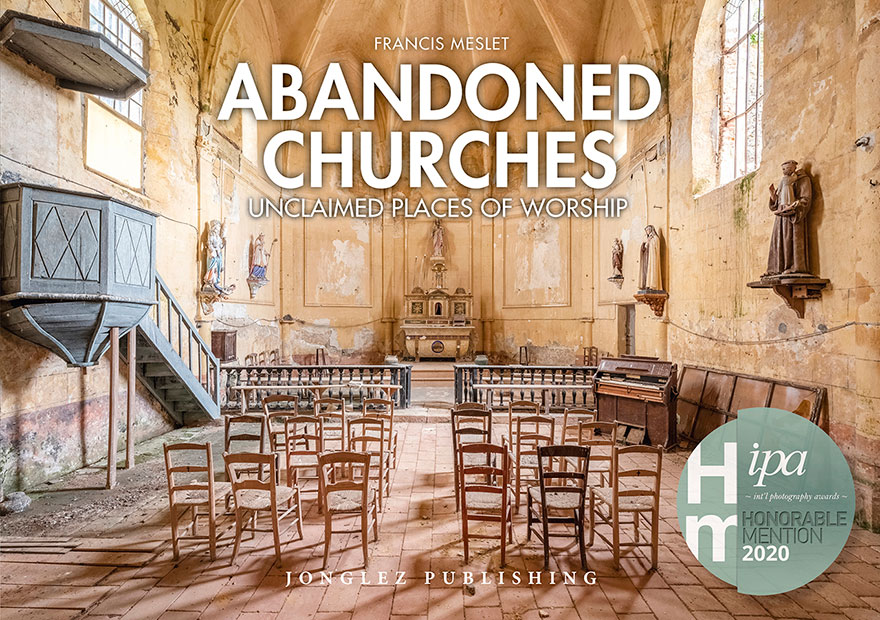
I'm agnostic but these beautiful photos almost otherworldly. They speak of a divine presence and give me hope amid our troubling times. Thank you for posting these works of art.
The churches I ever saw are always so dark and gloomy (even when still in use) yet here all the pictures are so bright , even the crypts ! I wonder if its natural lighting due to missing walls or ceilings, or is it artificially lighted for the purpose of the photo. Or the camera used is astonishingly sensitive in poor light conditions...
I'm agnostic but these beautiful photos almost otherworldly. They speak of a divine presence and give me hope amid our troubling times. Thank you for posting these works of art.
The churches I ever saw are always so dark and gloomy (even when still in use) yet here all the pictures are so bright , even the crypts ! I wonder if its natural lighting due to missing walls or ceilings, or is it artificially lighted for the purpose of the photo. Or the camera used is astonishingly sensitive in poor light conditions...

 Dark Mode
Dark Mode 

 No fees, cancel anytime
No fees, cancel anytime 








